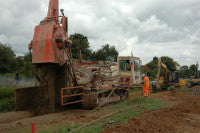Mastenbroek Trenchmix in Midlands Flood Relief
 A Mastenbroek TrenchMix machine, newly arrived from construction projects in France and Switzerland, is currently helping provide flood protection at a site of special scientific interest (SSSI) in Nottingham. The £650,000 contract is part of a broader £51 million Nottingham Left Bank Flood Alleviation Scheme for the Environment Agency and provides an alternative and economical solution to stopping water seeping beneath flood defences.
A Mastenbroek TrenchMix machine, newly arrived from construction projects in France and Switzerland, is currently helping provide flood protection at a site of special scientific interest (SSSI) in Nottingham. The £650,000 contract is part of a broader £51 million Nottingham Left Bank Flood Alleviation Scheme for the Environment Agency and provides an alternative and economical solution to stopping water seeping beneath flood defences.
The 50/60, owned by Heerschap BV Drainage of Holland, is being used by main contractor Jackson Civil Engineering. It uses the patented TrenchMix process, developed jointly by Mastenbroek and Bachy Soletanche, which involves the construction, below ground, of an impermeable cut-off wall comprising soil mixed with a binding agent. The technology is a natural development of Mastenbroek's extensive experience in trenching.
Last month, Environment Agency Midlands Director, Mark Sitton-Kent, visited the Attenborough site, which is host to a nature reserve, to inspect progress. It is believed the Mastenbroek is being used for the first time for flood defence works in the UK.
It is important to prevent seepage at Attenborough because the ground is highly permeable and the nature reserve features a number of lakes hosting many species of water fowl, flora and fauna . This means that, unless measures are taken to prevent it, the weight of floodwater could drive it underneath the flood wall towards sensitive areas behind the defences.
Sitton-Kent said: "We need to create a 'seepage cut-off', an impermeable barrier below ground level to prevent this from happening. The method we chose had to minimise the amount of land we needed to use, reduce disturbance to both people and wildlife and at the same time be able to work alongside high voltage electric cables and a major railway line to the satisfaction of Central Networks and Network Rail.
Initially, because of the ground conditions, the only possible solution seemed to be conventional hammer driven sheet piles. Trenchmix offered a new approach. It breaks up and mixes the soil with a cement grout without the need to excavate and remove it. The resulting mix of soil and grout solidifies to form a continuous underground barrier, preventing high flood levels driving water through the ground beneath the flood wall, and protecting the areas behind the defences.
Area Flood Risk Manager Innes Thomson says "Trenchmix offers significant benefits. It is faster than conventional sheet piling machines, and its lower noise and vibration levels will reduce disturbance to wildlife, visitors and local residents. We will also need to use less land to build the defence, and any earth excavated can be re-cycled on site for landscaping work. This will result in less traffic on local roads."
In addition to the specialised equipment provided by Mastenbroek, the TrenchMix process relies on a rigorous specification and detailed procedures drawn up by Bachy Soletanche to construct continuous impervious wall for foundations or leachate cut-off applications. Applications include buildings foundations, diaphragm walls for landfills, etc.
The TrenchMix process uses long established technologies in an innovative manner to develop a below ground barrier of very low permeability. Soil mixing technologies have been used throughout the construction industry to harden natural ground, providing either a more readily workable material or else a stiffened surface for trafficking and pollution control. This is done by mixing soils with relatively small amounts of either dry or wetted cement (or similar products). The cementitious material then stiffens the matrix of the soil leading to the formation of a barrier of substantially lower permeability than the previous natural ground.
TrenchMix uses a Mastenbroek trencher which is similar in appearance to those used for land drainage, but has a trenching boom that can be used in a vertical configuration while injecting slurry below ground during the excavation process. This creates a low permeability barrier required to form a seepage cut off and is used for both flood resistance and can also be used to stop the migration of any pollutants in, for example, a landfill site.
The Mastenbroek, with its long boom, is nevertheless highly manoeuvrable and capable of operating within a narrow corridor, as at Nottingham, with its adjacent railway track. The only raw material required is the cementitious grout. At the Nottingham site the material is strongly cementitious, containing no bentonite or similar materials. The water required to mix with the grout is abstracted from the adjacent lake, thus further reducing the required transportation costs and the use of potable water.
The grout is injected at a controlled rate into the soil. Given the relatively stiff nature of the mixing material it does not flow quickly away from this point but is moved by the direct mixing action of the boom and rapidly worked into the soil, forming a stiff material, retained in shape by the undisturbed adjacent ground. This material sets within hours - though, as with all cementitious materials, it only develops full strength after a longer period of curing.
The fact that the material is drawn to the surface also allows the operator the ability to observe the mixed material and to be sure that the derived quantity of material is being effectively mixed.
www.mastenbroek.com
